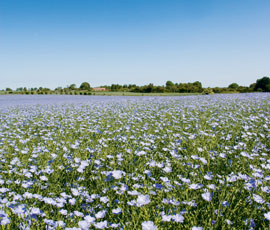Could linseed be an alternative crop for spring?

Tight supplies of spring cereal seed may see linseed in some rotations for the first time in years, as it can be drilled and harvested with the same equipment as oilseed rape.
“For some growers, linseed forms part of their rotation and we have growers who will plant 200-240ha of linseed every year, but in general terms we have seen the area shrink in favour of oilseed rape and wheat,” says Chris Spedding, director at Robin Appel.
“What makes a great sample of linseed is primarily down to the season – you need to harvest the crop at 9% moisture and keep the admixture below 2%. The overriding factor to gaining a good premium will be colour – what the baker wants to see is a shiny sample of uniform seeds,” he says.
This is a view shared by Richard Elsdon, technical manager at United Oilseeds. “The buyer buys with his eyes – if it is glossy and honey-coloured it will often fetch more money and go for human consumption.”
Like many specialist spring crops, linseed tends to be grown under contract and there are plenty of schemes to suit growers. “There is no futures market for linseed, so the crop is often traded using oilseed rape as its base value and then the grower could be offered a premium over rape,” says David Waite of Frontier Agriculture.
Typical contracts include either a fixed-price looking forward, a premium over the OSR price or a minimum/maximum contract. This type of contract basically ensures the grower gets a minimum price and, should the market slide, the buyer will forfeit the difference. In the event of the market exceeding the maximum price, the buyer will stand to benefit.
For those customers who are contracted to United Oilseeds, their linseed contract hinges on 50% of the crop at £350/t and 50% at market price at the time of collection.
The main brown varieties grown in the spring tend to be Brighton, (probably the most widely grown variety), Abacus and Bilton. The yellow linseed variety Marmalade has a similar oil content to its brown cousins and is used widely for human consumption, as well as the birdseed market. There are contracts available for yellow varieties and these tend to be traded at a premium over the brown varieties, but are generally slightly lower yielding
“Sowing dates ideally should be between mid-March to mid-April, but the important consideration is to get the crop up and away. It’s more about the conditions than the date,” says Mr Spedding.
“Seed rates need to be between 700-750 seeds/sq m to achieve a population of about 500-550 plants/sq m. Seed size can be variable, so adjust seed rate by calculating the thousandgrain weight.
“Regular linseed growers will have their own standards and ideas and will plant a rate that they know suits their farm,” says Mr Spedding.
“By targeting the correct seed rate, you will end up with the right plant population. You don’t want it planted too thick, because this leads to tall, leggy plants that don’t branch out.
“Conversely, you don’t want it planted too thin, because the plant won’t fill the canopy due to lack of competition and if the weather turns hot you don’t get the branching and pod formation. Like with rape it’s all about canopy management,” he says.
Most spring linseed seed will be treated with Chinook (cyfluthrin + imidacloprid) seed treatment to control flea beetle and this should give up to six weeks of protection.
Controlling flea beetles is crucial, as damage to the crop can be severe – they can eat away at the growing point and potential yield will be lost, says Chemega managing director Richard Pickford.
Once the seed treatment has worn off, growers will need to be vigilant and use a suitable insecticide if needed. “Pyrethroids will give some knockdown and one or more treatments may be required. The secret to this crop is getting it away well,” he says.
“When it comes to broad-leaved and grassweed control, there is not a huge choice,” says Mr Pickford. “Most of the controls seem to hinge around Chekker (iodosulfuron + amidosulfuron), Ally (metsulfuron) and Eagle (amidosulfuron).
Chekker is a post emergence product that combines some broadleaved and grassweed control and can be followed up by a graminicide for the control of volunteers and grassweeds.
Desiccation can either be done using Reglone (diquat) or Roundup (glyphosphate). If you use diquat you need to consider it close to harvesting, whereas with glyphosate you need to plan carefully in advance. “When it comes to desiccation, glyphosate is the way forward on price and performance,” says Mr Pickford.

